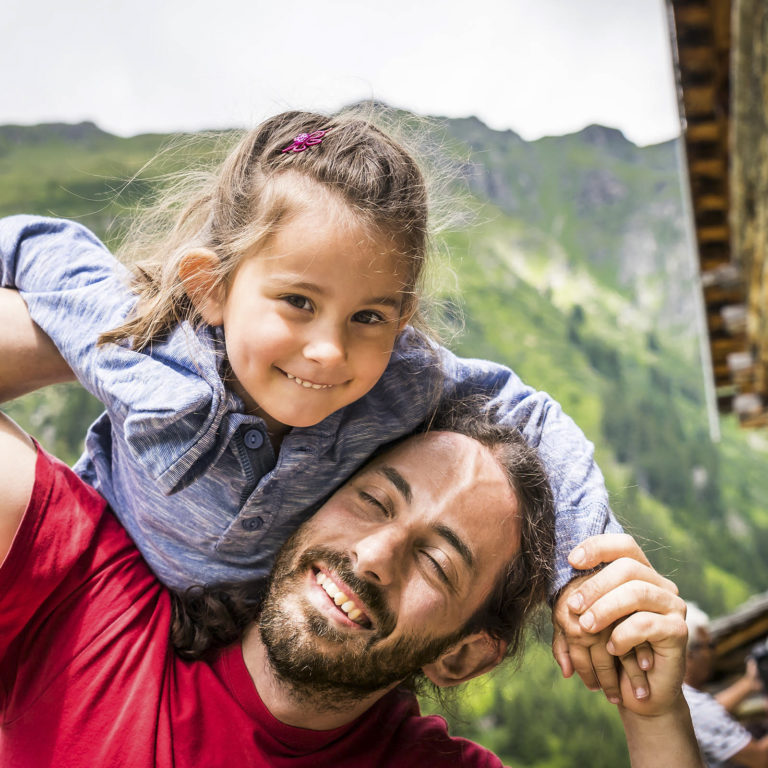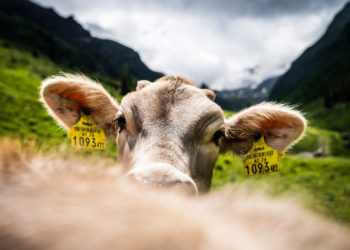
C Christian Kartnig und Töchterchen Julia, Alpe Garnera, Montafon © Dietmar Denger / Vorarlberg Tourismus
A micro-world of its own
Mountain time for the Kartnig family on the Garnera alp

C Christian Kartnig und Töchterchen Julia, Alpe Garnera, Montafon © Dietmar Denger / Vorarlberg Tourismus
Mountain time for the Kartnig family on the Garnera alp
The Garnera alp lies somewhat concealed in the Garneratal. Its inhabitants are the keepers of a very special treasure: Veronika and Christian produce “Sura Kees”, a landmark of the Montafon. We were lucky enough to get to watch them at work producing their cheese.
TEXT: ANNE SCHÜSSLER
Brown hair, big brown eyes, red trousers, pink socks: that’s Julia, five. She is stand ing on a wooden bench in front of the alpine hut. From a bouquet of colourful flowers on the table behind her she picks a yellow flower. Then she plucks the petals off one by one, throw ing them onto the floor in front of her. “Come butterfly, come!” she calls, and jumps excitedly up and down on the bench. Julia loves butterflies, and there are loads of them fluttering about up here, at an altitude of almost 1,700 metres. The Garnera alp is Julia’s entire world during the summer months. There is nothing up here to prevent her play – no roads, no cars. The little girl lives in the mountains with her parents Christian and Veronika Kartnig and her little sister between early July and mid September.
The Garnera alp is part of the three-phase agricultural system of alpine transhumance, which is a centuries-old practice in Vorarlberg. The farmers’ cows spend the summer months on the alp. They have the whole of the Garneratal to graze on – some of which is characterised by steep slopes, yet it also has many wild herbs and lush green meadows. Christian and Veronika milk the around 30 animals at the “Stofl”, where the alpine hut and the barn are located. For years, the milk was transported down into the valley, where it was sold to a dairy. These days, however, the couple use the milk to produce cheese, butter, yoghurt and quark themselves.
My parents have a farm, and as a child I used to come up here to the alp and help my cousin.
The Kartnig couple are well-known for their traditional Sura Kees, a cheese made from skimmed cow’s milk which has been around in the Montafon since the 12th century. First of all, Veronika skims the milk – later on she will use the cream to make butter. She then pours the skimmed milk into a wooden vat where the milk is stored for a couple of days and turns sour. No cultures at all are used in this process. This is the way tradition dictates. Veronika heats up the sour milk, producing a somewhat firmer component – known as “Bolma” – and the liquid whey. Veronika fills the Bolma into moulds. A day later, the cheese is salted and moved to the cheese cellar to mature. “These days, Sura Kees is usually eaten fresh, or with pumpkin seed oil or in a salad,” explains Veronika.
The Sura Kees resembles sheep’s cheese, but has a much milder, creamier taste. Of course, the best place to try it is where it is produced – on the Garnera alp. Take a seat on one of the rustic wooden benches, imbibe the delicious fragrance of the mountain meadows, take in the ringing of the cow bells and tuck in!
It is so peaceful, you would think somebody had turned off the sound of the world
Now, however, it’s time to get back to the base of our short tour: for several years now, guided tours to the Garnera alp have been available, starting from Gaschurn – and this morning we have joined hiking guide Gerhard Blaas to take such a tour. Gerhard has been living in Vorarlberg for 40 years, and shows guests the loveliest places that abound in his chosen home. Equipped with a felt hat and a pair of binoculars, he greets us at the Vernetta cable car station in Gaschurn at 8 a.m. This is where we start the two-hour tour to the Garnera alp. First of all, we take a gondola to the middle station, at an altitude of 1,400 metres. From here, we get an ex pansive view across Gaschurn towards Tyrol. And naturally, Gerhard knows the name of all the mountains.
The path towards the Garneratal winds its way through little forests and, sometimes, across country through the meadows. First of all we cross the alpine mountain pasture of Laminar and then continue along the Garnerabach. On the way, we hear nothing apart from the burbling of the water or the call of a bird. You would think somebody had turned off the sound of the world. Seriously peaceful.
Every few metres, Gerhard hops off the path and into the meadow, and shows us a plant – wood ragwort, white veratrum, arnica and bird’s foot trefoil. “Many of the plants have medicinal properties – in the olden days, farmers and shepherds used to pick the proper herb when injured,” he explains. He also relates a lot of information about the farmers’ life in the valley and on the alps. “Every farmer has to work up here in the spring in order to keep the alpine cultural landscape going,” he explains. The number of working days depends on the number of cows sent up to the milking alp during the summer months. The rule of thumb is: one working day per cow.
A wooden bench at the start of the Garneratal offers the chance to take a short break. From there, the 9.5km long valley stretches out in front of us and affords us an expansive view as far as the Plattenspitzen (2,883 metres). Director Joseph Vilsmeier was also enchanted by this view, and it was in this magical place that, in 1994, he shot the film “Schlafes Bruder” (“Brother of Sleep”), based on the novel of the same name by the Vorarlberg author Robert Schneider.
The adventure hike continues along the Garnerabach as far as the alp. Occasionally a call sounds. To us, it sounds like a bird of prey. Gerhard just laughs at us and points to a slope. Suddenly, something brown and fluffy hops through the grass. It’s a marmot! A few metres away is another one standing on the cliff, observing us – it doesn’t seem to feel threatened by us. It is only once you have seen one that you notice the others. They keep on appearing on the slopes and accompany us as far as our destination, the Garnera alp. Once hikers have made it to the top, a snack comprising cold cuts and a glass of milk awaits them – including an inquisitive crowd. Now and again, a cow plucks up the courage to go up to the alp, observing us inquisitively as we eat.
The oldest of the huts, the Ganeu alpine pasture, has been braving the weather for 500 years
We have to make our way back down far too soon. This takes us past the Ganeu alpine pasture, where the oldest double barn in the Montafon from 1522 is located. Despite the weather and the snowfall, it has been well preserved. “Several families take advantage of the cows being on the milking alp on the mountain to renovate their houses,” says hiking guide Gerhard, pointing at a building right down the slope. Two men are sitting on the roof constructing wooden roof shingles.
“They are renewing the house in line with the traditional construction method,” explains the hiking guide. The path down the mountain takes you through a forested area before it winds across a stream and a meadow. From here, we get a great view of Gaschurn. It will take a while before Julia and her parents return to Gaschurn. It is not until September that they and their cows leave the Garnera alp and return to their house in the valley. Then they once again go about their actual jobs – Veronika is a graphic designer and Christian is a programmer. Julia will have to live without her butterflies, unless one flies to the valley by mistake.

The grazing livestock in Vorarlberg doesn’t have time to get bored – it keeps on moving pastures. Alpine transhumance has been practiced for many centuries in Vorarlberg. It has been on UNESCO’s Intangible Cultural Heritage list since 2011. The three-phase system comprises the following: after the thaw, the cattle grazes in the valleys, then they head up to the alpine mountain pastures at medium altitude. Subsequently the animals spend the summer in the high alps. The variety of herbs to be found there is not only healthy – they guarantee particularly aromatic milk and, hence, the basic ingredient for the lovely, tasty alpine cheese.